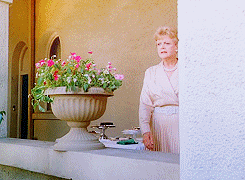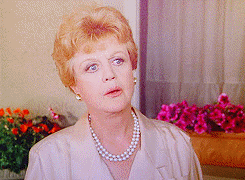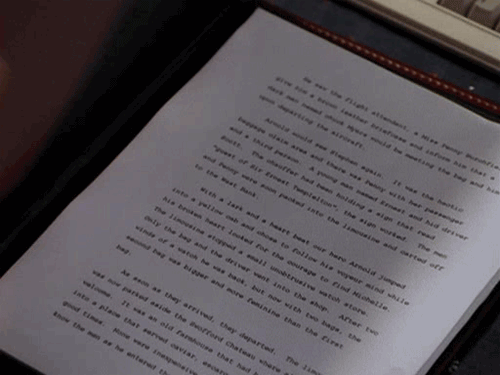Howard Hardiman fucking loves sign-language, knows quite a lot about ketamine, and has a smile for strangers that I’d bet stops babies crying. He’s the creator of The Lengths and Badger, co-creator on Angela and The Invalids, as well as Artist in Residence at Quay Arts on the Isle of Wight. He used to be a sign-language interpreter and has a way of saying “diversity strands” and “intersectionality” like they’re obvious common sense (I’m not arguing). Hardiman’s been coming to Leeds for Thought Bubble–his favoured UK convention–for “ages”. This is where I find him, Saturday, November the twenty-third, 2013. These are his books.
———————–
 Angela is a collaboration with poet Chrissy Williams, an illustrated chapbook more than a comic proper, and in the artist’s words a story from the perspective of an “obsessed stalker” who cannot differentiate between “Angela Lansbury” and “Jessica B Fletcher”–Lansbury’s character in that good ol’ eighties-nineties New Englandy detective drama Murder She Wrote. Turn on your TV; an episode will eventually play.
Angela is a collaboration with poet Chrissy Williams, an illustrated chapbook more than a comic proper, and in the artist’s words a story from the perspective of an “obsessed stalker” who cannot differentiate between “Angela Lansbury” and “Jessica B Fletcher”–Lansbury’s character in that good ol’ eighties-nineties New Englandy detective drama Murder She Wrote. Turn on your TV; an episode will eventually play.
 Hardiman was initially keen to do the project as he wanted to improve his skill at likenesses, but found the greatest artistic resistance in the classic MSW title-sequence typewriter. “You should have just used the computer from the later seasons!”, I chide helpfully. But it is a very nicely done typewriter. As for the likenesses–I recently bought a new wardrobe and hold no greater ambition for it than to line the drawers with wallpaper, as a Victorian (Edwardian?) maiden might; line them with wallpaper printed from Howard Hardiman’s Lansbury Faces pattern (seen on the frontispiece and end-paper). Perhaps I am closer to the narrator of this poem than might be prudent to admit. Forgive my filthy bias. It’s a very good little book.
Hardiman was initially keen to do the project as he wanted to improve his skill at likenesses, but found the greatest artistic resistance in the classic MSW title-sequence typewriter. “You should have just used the computer from the later seasons!”, I chide helpfully. But it is a very nicely done typewriter. As for the likenesses–I recently bought a new wardrobe and hold no greater ambition for it than to line the drawers with wallpaper, as a Victorian (Edwardian?) maiden might; line them with wallpaper printed from Howard Hardiman’s Lansbury Faces pattern (seen on the frontispiece and end-paper). Perhaps I am closer to the narrator of this poem than might be prudent to admit. Forgive my filthy bias. It’s a very good little book.
In 2013 I decided: “this is the year I begin to really get poetry”. I have not come far–if you write poems, please introduce them to me–so what luck, what a boon, that this is a poem I easily dig. I am not in the grasp of a dangerous fixation (please: the benefit of the doubt) but I sure do love me some Murder She Wrote, and I both own and watch a twenty-pence VHS copy of Ms Lansbury’s Positive Moves workout video. It’s very refreshing.
So I was on board as soon as I heard “Angela Lansbury” + “comic”. Yes. But I’m so relieved to believe that it’s a power of a poem! Like water, it meanders around the happenings of the suggested stalker/stalkee narrative; we’re looking at a photograph of a river with the banks blacked out. I can’t tell you the variety of grasses or which meadow plants grow upon the land, but I comprehend the basic shape of its formation, and my eyes are glued to the river itself–details and classification of anything but the water would obscure the aesthetic flow.
There is blood here–Angela.
I don’t know whose blood it is.
I’m starting to think–Angela.
I’m starting to think.
I’ve never had to fear myself, as the voice of this poem does (and the culprits of Murder She Wrote do). But I’ve had some times in this head of mine, and I can recognise the pull of the internal irrational. I can see that these thought patterns “make sense”, in that they don’t make sense, unless you can remember how “nervous” feels, and extrapolate. I think it’s emotionally plausible as well as well-written.
 Hardiman’s illustrations drift above and sometimes below the pull of the poem, bringing familiar faces from the show together with darkness and dangerous colours that shouldn’t go there. I see Mort*, I see Seth**, I see… David Lynch? I see Jack “Johnny” Nicholson, and that’s not right at all. A familiar scene from the credits is made sinister; Angela’s eyes are whited out, blacked out, and finally rendered cold and full of nothing. To read Angela all the way through is like sliding the highest, longest flume-tube slide when you’re young; dark, and flashing, and fun. Because it’s scary, and you’re right there.
Hardiman’s illustrations drift above and sometimes below the pull of the poem, bringing familiar faces from the show together with darkness and dangerous colours that shouldn’t go there. I see Mort*, I see Seth**, I see… David Lynch? I see Jack “Johnny” Nicholson, and that’s not right at all. A familiar scene from the credits is made sinister; Angela’s eyes are whited out, blacked out, and finally rendered cold and full of nothing. To read Angela all the way through is like sliding the highest, longest flume-tube slide when you’re young; dark, and flashing, and fun. Because it’s scary, and you’re right there.

———————–
 The Lengths was a two-year self-published series, but found itself picked up by a publisher and was just released in hardback, autumn-winter 2013. The story is based on interviews Hardiman did with male sex workers, and I carelessly did not ask whether the interviews were designed to inform the story or if they had another original purpose. In The Lengths everybody is a dog (literally), every character is a man. Having heard Hardiman talk on Thought Bubble’s Diversity in Comics panel, chat with myself and with other con-goers about the various stupidities of our compassion-lite world, I am willing to chance that this could be that rare case when blokes are purposefully isolated in order for blunt study to be done without dilution; to magnify or refine the focus and rule out escape from observation. Come here, men. Get under this microscope.
The Lengths was a two-year self-published series, but found itself picked up by a publisher and was just released in hardback, autumn-winter 2013. The story is based on interviews Hardiman did with male sex workers, and I carelessly did not ask whether the interviews were designed to inform the story or if they had another original purpose. In The Lengths everybody is a dog (literally), every character is a man. Having heard Hardiman talk on Thought Bubble’s Diversity in Comics panel, chat with myself and with other con-goers about the various stupidities of our compassion-lite world, I am willing to chance that this could be that rare case when blokes are purposefully isolated in order for blunt study to be done without dilution; to magnify or refine the focus and rule out escape from observation. Come here, men. Get under this microscope.
CN: Those you interviewed… Did they read the book? Did they like it?
HH: Yeah, yeah, they did like it, mostly! Some had to read some “uncomfortable truths”, I guess, which was… a bit awkward. Those who weren’t interviewed, men and women who also work in that field, say, “Well, it’s not my story, but it’s authentic.” You know? Some say, “This guy’s a dick! It’s not for him but he keeps doing it–what an idiot”. Because on the whole if you don’t like it, you stop doing it, right? The character, he doesn’t really like it, it doesn’t really suit him, but he keeps doing it. And he hasn’t told his boyfriend.
HH: I wanted something different in gay comics… People seem to either want porn, or essentially stories about straight men who like other straight men.
I don’t know whether the character designs all being dog-headed men is artistic endeavour or fear of being crap at likenesses (I’ll hazard a guess: both). It’s funny, though, because however good he is or isn’t at drawing a human face, H. Hardiman’s skill at evoking one through animal reduction is enviable. I understand these men, immediately. I’m able to suppose a human face from the dogsbody symbolism if I give it a few seconds’ effort, absolutely, but I don’t need to do this in order to see “who they are”. This is multi-level character design, and that should be celebrated.
———————–
 Hardiman and artist Sarah Gordon are currently stalled at work on The Invalids, previously seen in print as The Peckham house for Invalids or The Peckham Invalids. Tragically out-of-print, about “teenage disabled Edwardian superheroines”, and pretty amazing-sounding (I left heartfelt instruction to please, let me know when the book is coming up for publication; don’t worry about forgetting this project if you’re a WWAC regular), Hardiman says that after doing an all-male story with The Lengths he thought “I want to give power to those who had the very least”. Speaking during and immediately after Thought Bubble’s Diversity in Comics panel again, about the narratives of heroism surrounding physical disability and popular morality/ability dichotomy (in response to a question about whether the 2012 Paralympic success had improved visibility and public image for people living with disability: “No”***), he’s sure to make the point that the girls’ powers do not counterbalance, or ~make up for, their disabilities. The girl who is deaf is super-strong, and she is bad at lip reading (“most people are”); once she joins a ruckus it’s “quite hard to get her to stop”. For the girl who is blind, her power is not related to sight or visualised perception. There are no Geordie LaForge viewing gadgets, no Daredevil awareness radar. (There is quite a lot of scoffing about Daredevil as an agent of diversity in comics.)
Hardiman and artist Sarah Gordon are currently stalled at work on The Invalids, previously seen in print as The Peckham house for Invalids or The Peckham Invalids. Tragically out-of-print, about “teenage disabled Edwardian superheroines”, and pretty amazing-sounding (I left heartfelt instruction to please, let me know when the book is coming up for publication; don’t worry about forgetting this project if you’re a WWAC regular), Hardiman says that after doing an all-male story with The Lengths he thought “I want to give power to those who had the very least”. Speaking during and immediately after Thought Bubble’s Diversity in Comics panel again, about the narratives of heroism surrounding physical disability and popular morality/ability dichotomy (in response to a question about whether the 2012 Paralympic success had improved visibility and public image for people living with disability: “No”***), he’s sure to make the point that the girls’ powers do not counterbalance, or ~make up for, their disabilities. The girl who is deaf is super-strong, and she is bad at lip reading (“most people are”); once she joins a ruckus it’s “quite hard to get her to stop”. For the girl who is blind, her power is not related to sight or visualised perception. There are no Geordie LaForge viewing gadgets, no Daredevil awareness radar. (There is quite a lot of scoffing about Daredevil as an agent of diversity in comics.)
When he thinks about things, says Hardiman, he finds he is “quite angry”. Consequentially The Invalids has become gorier. I’m terribly, terribly curious at this, and sad to not be reading it right now. Currently he and Gordon are looking for a publisher willing to support the work of the artist: “Let’s be honest,” says Hardiman, “people think it is, but the workload is really not a fifty-fifty split. I need to be able to pay her for doing the bulk of the work.”
You could call that basic courtesy, but are we all honest enough to give credit where it’s due? Tell me if you spot a slip-up, but I reckon this guy is good people.
———————–
 The Badger story originally saw life as post-its on flickr. As can happen, it exploded, got published, got reviewed, and had lots of creative interpretations which you may peruse online at your leisure. Basically, it’s a semi-autobio job after Hardiman’s “light depression” following the injury that stopped his work as a sign-language interpreter. Like I said: he really, really seems to like sign language.
The Badger story originally saw life as post-its on flickr. As can happen, it exploded, got published, got reviewed, and had lots of creative interpretations which you may peruse online at your leisure. Basically, it’s a semi-autobio job after Hardiman’s “light depression” following the injury that stopped his work as a sign-language interpreter. Like I said: he really, really seems to like sign language.
———————–
“Howard Hardiman” was a nameless stranger to me, whose art and stories I’d never seen. I reckon that was my loss; I hope that you agree.
* Watch more Murder She Wrote there, Hoss
** Seriously though. See above
*** Hardiman suffers chronic pain; as a result there’s “so much stuff I can’t fucking do”. Creating a social atmosphere that puts morality and characteristic heroism in small gilded pots on a single, canonised shelf, to which one must climb along a pre-identified route for a smash’n’grab, might naturally be observed as unfair by those who cannot complete this.



